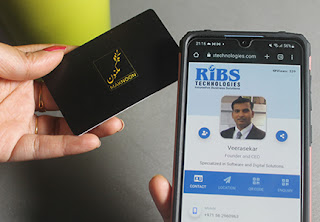Designing Digital Business Cards that Drive Clicks and Actions
In today's fast-paced digital world, traditional business cards are slowly being overshadowed by their digital counterparts. A Digital Business Card not only offers an eco-friendly alternative but also brings in interactive features that are not possible with paper. But how can you ensure that your card is not just another link or QR code in the sea of online content? The key is to make it actionable and clickable. Here's how you can design a Digital Business Card that genuinely drives clicks and actions.
1. Understand the Essence of a Digital Business Card
Before diving into design, understand what a Digital Business
Card is. It's not just a digital representation of your physical card.
It’s an interactive platform that bridges the gap between your offline and
online professional persona. It can include links to your portfolio, social
media, or even interactive videos.
2. Keep it Simple yet Attractive
An overly cluttered card can be off-putting. Stick to the
essential information: name, designation, company, contact details, and perhaps
a few critical links or QR codes. The design should be clean, with ample white
space to make the content pop.
3. Make Use of Interactive Elements
This is where the digital aspect shines. Use buttons for
your social media profiles, embed videos or infographics, or even add a chatbot
for immediate inquiries. The goal is to encourage the viewer to interact with
your card, leading to more clicks and actions.
4. Ensure Mobile Responsiveness
Most people will view your Digital Business Card on their
mobile devices. Therefore, ensuring that your card is mobile-friendly and looks
good on all screen sizes is crucial. Use flexible grids and scalable images to
achieve this.
5. Optimize for Quick Loading
Just like any webpage, if your card takes too long to load,
people might abandon it. Optimize images, use web-friendly fonts, and limit the
number of embedded videos or elements to ensure a swift loading time.
6. Integrate Clear Call-to-Actions (CTAs)
If you want action, direct your viewer towards them. Include
clear CTAs like "View Portfolio," "Schedule a Meeting," or
"Drop me an Email." Make these buttons or links stand out but ensure
they don't overshadow the essential details.
7. Update Regularly
The beauty of a Digital Business Card is that it's not
static. As you move jobs, acquire new skills, or have updated work to showcase,
make sure your card reflects these changes. This not only ensures accuracy but
also shows professionalism.
8. Integrate Analytics
To understand if your card is driving the desired clicks and
actions, embed analytics. Tools like Google Analytics can help you track the
number of views, clicks, and other interactions.
9. Promote your Digital Business Card
Simply creating an impressive card isn't enough. Share it on
your email signatures, social media profiles, and even on your traditional
business card. The more visibility it gets, the more chances of interaction.
10. Feedback Loop
Finally, always be open to feedback. If colleagues or
contacts have suggestions or face issues with your card, use that feedback to
make improvements.
In conclusion, a Digital Business Card offers a dynamic way to represent yourself or your business in the digital realm. With the right design elements, CTAs, and interactive features, you can ensure that your card doesn't just get viewed but also prompts valuable actions.




Comments
Post a Comment